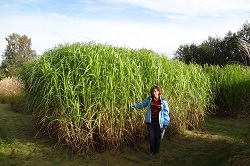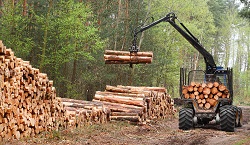Making more of Misanthus
The fast growing grass Miscanthus is likely to become Europe’s major biomass crop and a big part of the transition to a sustainable bio-energy economy. ‘The remarkable ability of Miscanthus to adapt makes this novel crop suitable for production over a range of climatic conditions,’ says Professor Iris Lewandowski from Hohenheim University, Stuttgart and co-ordinator of the OPTIMISC (Optimizing Miscanthus Biomass Production) project, which in 2012 was tasked to find the optimal hybrid of Miscanthus for use as a feedstock for biofuels and bio-materials. ‘Because it is a perennial crop, which is planted only once in a plantation life-time of 20 years, Miscanthus contributes to improved soil fertility, soil carbon storage, biodiversity, efficient nutrient use and has very low fertilization and pesticide demands, ’ explains Lewandowski, ‘But presently there is a single cloned variety, Miscanthus x giganteus, available for European farmers. That means there are no Miscanthus varieties tailored to different environments or biomass use options.’ Large-scale Miscanthus trials The 12 OPTIMISC partners (including participants in Turkey, China and Russia) started to identify new micanthus plants adapted to different climatic conditions such as frost, drought and salinity. The team bred over 150 different varieties from seed or created from new hybrid plants. Field trials on a final 15 varieties assessed their suitability for different environments and different uses such as the production of ethanol and biogas and combustion. A total of 22 200 plants were produced for six major trials, carried out in Turkey, Germany, Ukraine, the Netherlands, the UK and Russia, plus 40 000 plants in further large-scale trials, including trials in China, to find varieties that could grow in saline conditions. OPTIMISC results have demonstrated that new hybrids can out-yield the standard commercially grown Miscanthus variety. To understand why some varieties out-perform others the team carried out physiological analysis of different plants. Their results allow a better understanding of the relationship between plant growth rates and environmental conditions and which varieties will flourish in different environments. ‘Results also demonstrated the potential of Miscanthus as a crop for growth on marginal land,’ adds Lewandowski. Optimising production The data collected in the project will now help optimise production methods. The project looked at ways of improving technologies for the commercial implementation of Miscanthus-based biomass production processes. They analysed field methods for seed establishment, harvesting methods, and pelleting technologies that allow biomass material to be concentrated. ‘Our findings on the performance of different Miscanthus varieties have now been incorporated into different Miscanthus breeding programmes and the first new commercial varieties are close to market introduction’ says Lewandowski. OPTIMISC models have also confirmed the potential for yearly greenhouse gas emission savings equivalent to 30.6 tons of carbon dioxide per hectare of Miscanthus grown. ‘OPTIMISC results are being presented to the biomass and biorefinery industries to also demonstrate the economic case for Miscanthus biomass’ she adds.
Keywords
OPTIMISC, biofuel, grasses, yield, lignocellulose, biomass quality, plant breeding, Miscanthus




